|
Electromagnetic Field (festival)
Electromagnetic Field (also known as EMF, or EMF Camp) is a camping festival in the UK, held every two years, for Hacker (hobbyist), hackers, geeks, engineers and scientists. It features talks and workshops covering a wide variety of topics. EMF is a non-profit event run entirely by a team of volunteers. Attendees of EMF receive an Electronic badge, electronic conference badge, funded by sponsorship, which in 2014 included an LCD screen, Arduino-compatible microcontroller, and a radio transceiver. History The first Electromagnetic Field event was held in 2012 at Pineham Park, near Milton Keynes, and completely sold out a 499-person capacity. Each tent at EMF 2012 was provided with power and the internet, via a 2.5 km direct microwave link to a data centre which provided 370 Mbit/s to the campsite. Over 50 speakers gave talks, including Ben Goldacre. In 2013, a smaller interim one-day event called Electromagnetic Wave was held in London on board the Stubnitz (ship), MS St ... [...More Info...] [...Related Items...] OR: [Wikipedia] [Google] [Baidu] |
Hacker (hobbyist)
The hacker culture is a subculture of individuals who enjoy—often in collective effort—the intellectual challenge of creatively overcoming the limitations of software systems or electronic hardware (mostly digital electronics), to achieve novel and clever outcomes. The act of engaging in activities (such as programming or other mediaThe Hacker Community and Ethics: An Interview with Richard M. Stallman, 2002 (gnu.org)) in a spirit of playfulness and exploration is termed ''hacking''. However, the defining characteristic of a is not the activities performed themselves (e.g. [...More Info...] [...Related Items...] OR: [Wikipedia] [Google] [Baidu] |
Loseley Park
Loseley Park is a large Tudor manor house with later additions and modifications south-west of Guildford, Surrey, England, in Artington close to the hamlet of Littleton. The estate was acquired by the direct ancestors of the current owners, the More-Molyneux family, at the beginning of the 16th century. The house built for Sir William More is a Grade I listed building, the highest rank in architecture or heritage. Loseley appears in the Domesday Book of 1086 as ''Losele''. It was held by Turald (Thorold) from Roger de Montgomery. Its Domesday assets were: 2 hides. It had 4 ploughs, of meadow. It rendered £3. The papers of Sir Thomas Cawarden, Master of the Revels, were formerly preserved in the house. Loseley Park is still the residence of the More-Molyneux family and is open to the public. The 17th-century tithe barn is available for weddings. The house The present house was built between 1562 and 1568 with stone brought from the ruins of Waverley Abbey. The new house rep ... [...More Info...] [...Related Items...] OR: [Wikipedia] [Google] [Baidu] |
Counterculture Festivals
A counterculture is a culture whose values and norms of behavior differ substantially from those of mainstream society, sometimes diametrically opposed to mainstream cultural mores.Eric Donald Hirsch. ''The Dictionary of Cultural Literacy''. Houghton Mifflin. . (1993) p. 419. "Members of a cultural protest that began in the U.S. In the 1960s and Europe before fading in the 1970s... fundamentally a cultural rather than a political protest." A countercultural movement expresses the ethos and aspirations of a specific population during a well-defined era. When oppositional forces reach critical mass, countercultures can trigger dramatic cultural changes. Prominent examples of countercultures in the Western world include the Levellers (1645–1650), Bohemianism (1850–1910), the more fragmentary counterculture of the Beat Generation (1944–1964), followed by the globalized counterculture of the 1960s (1964–1974). Definition and characteristics John Milton Yinger originated the t ... [...More Info...] [...Related Items...] OR: [Wikipedia] [Google] [Baidu] |
2012 Establishments In England
1 (one, unit, unity) is a number representing a single or the only entity. 1 is also a numerical digit and represents a single unit of counting or measurement. For example, a line segment of ''unit length'' is a line segment of length 1. In conventions of sign where zero is considered neither positive nor negative, 1 is the first and smallest positive integer. It is also sometimes considered the first of the infinite sequence of natural numbers, followed by 2, although by other definitions 1 is the second natural number, following 0. The fundamental mathematical property of 1 is to be a multiplicative identity, meaning that any number multiplied by 1 equals the same number. Most if not all properties of 1 can be deduced from this. In advanced mathematics, a multiplicative identity is often denoted 1, even if it is not a number. 1 is by convention not considered a prime number; this was not universally accepted until the mid-20th century. Additionally, 1 is ... [...More Info...] [...Related Items...] OR: [Wikipedia] [Google] [Baidu] |
Netherlands
) , anthem = ( en, "William of Nassau") , image_map = , map_caption = , subdivision_type = Sovereign state , subdivision_name = Kingdom of the Netherlands , established_title = Before independence , established_date = Spanish Netherlands , established_title2 = Act of Abjuration , established_date2 = 26 July 1581 , established_title3 = Peace of Münster , established_date3 = 30 January 1648 , established_title4 = Kingdom established , established_date4 = 16 March 1815 , established_title5 = Liberation Day (Netherlands), Liberation Day , established_date5 = 5 May 1945 , established_title6 = Charter for the Kingdom of the Netherlands, Kingdom Charter , established_date6 = 15 December 1954 , established_title7 = Dissolution of the Netherlands Antilles, Caribbean reorganisation , established_date7 = 10 October 2010 , official_languages = Dutch language, Dutch , languages_type = Regional languages , languages_sub = yes , languages = , languages2_type = Reco ... [...More Info...] [...Related Items...] OR: [Wikipedia] [Google] [Baidu] |
Hack-Tic
''Hack-Tic'' was a Dutch hacker magazine published between 1989 and 1994. Throughout its existence, ''Hack-Tic'' had a cult following and upset the authorities beyond the Dutch borders. History In 1988, a small delegation from the Chaos Computer Club in Hamburg visited Amsterdam after being invited by Caroline Nevejan, who organized political events at Paradiso in Amsterdam. Rop Gonggrijp, the magazine's later editor and publisher was at that point already rather well known as a hacker who sometimes appeared in the newspapers. Being inspired by '' Datenschleuder'' (the CCC magazine) and '' 2600 The Hacker Quarterly'', Gonggrijp decided to start his own magazine. In January 1989, the first issue was published. That summer, Nevejan, Gonggrijp and Patrice Riemens organized the Galactic Hacker Party in Paradiso, Amsterdam. The magazine grew from its original circulation of 50 photocopies to several thousand printed issues. A group of authors published wide-ranging articles includi ... [...More Info...] [...Related Items...] OR: [Wikipedia] [Google] [Baidu] |
Germany
Germany,, officially the Federal Republic of Germany, is a country in Central Europe. It is the second most populous country in Europe after Russia, and the most populous member state of the European Union. Germany is situated between the Baltic and North seas to the north, and the Alps to the south; it covers an area of , with a population of almost 84 million within its 16 constituent states. Germany borders Denmark to the north, Poland and the Czech Republic to the east, Austria and Switzerland to the south, and France, Luxembourg, Belgium, and the Netherlands to the west. The nation's capital and most populous city is Berlin and its financial centre is Frankfurt; the largest urban area is the Ruhr. Various Germanic tribes have inhabited the northern parts of modern Germany since classical antiquity. A region named Germania was documented before AD 100. In 962, the Kingdom of Germany formed the bulk of the Holy Roman Empire. During the 16th ce ... [...More Info...] [...Related Items...] OR: [Wikipedia] [Google] [Baidu] |
Chaos Communication Camp
The Chaos Communication Camp (also known as CCCamp) is an international meeting of hackers that takes place every four years, organized by the Chaos Computer Club (CCC). So far all CCCamps have been held near Berlin, Germany. The camp is an event for providing information about technical and societal issues, such as privacy, freedom of information and data security. Hosted speeches are held in big tents and conducted in English as well as German. Each participant may pitch a tent and connect to a fast internet connection and power. List of Camps See also * Chaos Communication Congress, an annual indoor event, held in December in Germany * Hack-Tic hacker events, a quadrennial outdoor event, held in August in the Netherlands * Electromagnetic Field An electromagnetic field (also EM field or EMF) is a classical (i.e. non-quantum) field produced by (stationary or moving) electric charges. It is the field described by classical electrodynamics (a classical field theo ... [...More Info...] [...Related Items...] OR: [Wikipedia] [Google] [Baidu] |
Newton Longville
Newton Longville is a village and civil parish in the unitary authority area of Buckinghamshire, England. The village is about south-west of Bletchley. History The toponym "Newton" is derived from the Old English for "new farm". It is recorded in the Domesday Book of 1086 as ''Nevtone''. The affix "Longville" was added in the 13th century after the Cluniac priory of Longueville, Calvados, in Normandy, France, that held the manor of Newton at that time, and to distinguish this village from other places called Newton, particularly nearby Newton Blossomville. In 1441, when its previous holder died without an heir, the Crown bestowed the manor on the Warden and fellows of New College, Oxford. Parts of the Church of England parish church of Saint Faith are late 12th century, but the exterior is largely Perpendicular Gothic. Newton Longville has a number of cruck-framed thatched houses dating from the mid to late 15th century, with good examples at Moor End. Newton Longville ... [...More Info...] [...Related Items...] OR: [Wikipedia] [Google] [Baidu] |
COVID-19 Pandemic
The COVID-19 pandemic, also known as the coronavirus pandemic, is an ongoing global pandemic of coronavirus disease 2019 (COVID-19) caused by severe acute respiratory syndrome coronavirus 2 (SARS-CoV-2). The novel virus was first identified in an outbreak in the Chinese city of Wuhan in December 2019. Attempts to contain it there failed, allowing the virus to spread to other areas of Asia and later worldwide. The World Health Organization (WHO) declared the outbreak a public health emergency of international concern on 30 January 2020, and a pandemic on 11 March 2020. As of , the pandemic had caused more than cases and confirmed deaths, making it one of the deadliest in history. COVID-19 symptoms range from undetectable to deadly, but most commonly include fever, dry cough, and fatigue. Severe illness is more likely in elderly patients and those with certain underlying medical conditions. COVID-19 transmits when people breathe in air contaminated by droplets and ... [...More Info...] [...Related Items...] OR: [Wikipedia] [Google] [Baidu] |
Eastnor Castle
Eastnor Castle, Eastnor, Herefordshire, is a 19th-century mock castle. Eastnor was built for John Cocks, 1st Earl Somers, who employed Robert Smirke, later the main architect of the British Museum. The castle was built between 1811 and 1820. Major schemes of interior decoration were carried out by A.W.N. Pugin in 1849–1850. Eastnor remains a private home, and is currently the residence of James Hervey-Bathurst, the grandson of Arthur Somers-Cocks, 6th Baron Somers. It is a Grade I listed building. The surrounding gardens and parkland are designated Grade II*. The castle is open to tours by the public on certain months of the year; it is also a wedding venue. History The estate was established in the late 16th century when the Cocks family purchased land in the area. Subsequent marriages into the Somers and Nash families helped provide the wealth and substance necessary to build the present imposing building, designed to look like one of the medieval castles guarding the Wels ... [...More Info...] [...Related Items...] OR: [Wikipedia] [Google] [Baidu] |
Stroopwafel
A ''stroopwafel'' (; literally 'syrup waffle') is a thin, round waffle cookie made from two layers of sweet baked dough held together by caramel filling.Stroopwafels. Een traditionele Goudse lekkernij Retrieved on 2 January 2008. |






